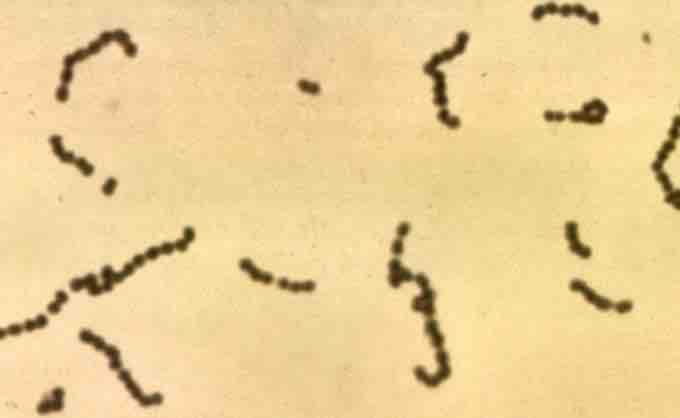Firmicutes
From Latin: firmus, strong; cutis, skin; referring to the cell wall. These are a phylum of bacteria, most of which have Gram-positive cell wall structure . A few, however, such as Megasphaera, Pectinatus, Selenomonas and Zymophilus, have a porous pseudo-outer-membrane that causes them to stain Gram-negative.
Humans use of prokaryotes
This is a microscopic image of Bacillus subtilis (ATCC 6633) with a gram staining of magnification: 1,000. The oval, unstained structures are spores.
Scientists once classified the Firmicutes to include all Gram-positive bacteria, but have recently defined them to be of a core group of related forms called the low-G+C group, in contrast to the Actinobacteria.
They have round cells, called cocci (singular, coccus), or rod-like forms (bacillus). Many Firmicutes produce endospores, which are resistant to desiccation and can survive extreme conditions. They are found in various environments, and the group includes some notable pathogens. Those in one family, the heliobacteria, produce energy through photosynthesis. Firmicutes play an important role in beer, wine, and cider spoilage.The group is typically divided into the Clostridia, which are anaerobic, the Bacilli, which are obligate or facultative aerobes, and the Mollicutes.
LACTIC ACID BACTERIA (LAB)
These comprise a class of Firmicutes and are Gram-positive, low-GC, acid-tolerant, generally non-sporulating, non-respiring rod or cocci that are associated by their common metabolic and physiological characteristics.
These bacteria, usually found in decomposing plants and lactic products, produce lactic acid as the major metabolic end-product of carbohydrate fermentation. This trait has, throughout history, linked LAB with food fermentations as acidification inhibits the growth of spoilage agents. Proteinaceous bacteriocins are produced by several LAB strains and provide an additional hurdle for spoilage and pathogenic microorganisms.
Furthermore, lactic acid and other metabolic products contribute to the organoleptic and textural profile of a food item. The industrial importance of the LAB is further evinced by their generally recognized as safe (GRAS) status, due to their ubiquitous appearance in food and their contribution to the healthy microflora of human mucosal surfaces, particularly the gastrointestinal tract.
The lactic acid bacteria (LAB) are rod-shaped bacilli or cocci , characterized by an increased tolerance to a lower pH range. This aspect partially enables LAB to outcompete other bacteria in natural fermentation, as they can withstand the increased acidity from organic acid production (e.g., lactic acid).

Streptococci
Light microscopy view of streptococci, a non-sporulating lactic acid bacteria.
LAB PATHWAYS
LAB are amongst the most important groups of microorganisms used in the food industry. Two main hexose fermentation pathways are used to classify LAB genera. Under conditions of excess glucose and limited oxygen, homolactic LAB catabolize one mole of glucose in the Embden-Meyerhof-Parnas pathway to yield two moles of pyruvate. Intracellular redox balance is maintained through the oxidation of NADH, concomitant with pyruvate reduction to lactic acid. This process yields two moles of ATP per mole of glucose consumed.
Representative homolactic LAB genera include Lactococcus, Enterococcus and Streptococcus. Heterofermentative LAB in turn use the pentose phosphate pathway, alternatively referred to as the pentose phosphoketolase pathway. One mole of glucose-6-phosphate is initially dehydrogenated to 6-phosphogluconate and subsequently decarboxylated to yield one mole of CO2. The resulting pentose-5-phosphate is cleaved into one mole glyceraldehyde phosphate (GAP) and one mole acetyl phosphate. GAP is further metabolized to lactate as in homofermentation, with the acetyl phosphate reduced to ethanol via acetyl-CoA and acetaldehyde intermediates.
In theory, end-products (including ATP) are produced in equimolar quantities from the catabolism of one mole of glucose. Obligate heterofermentative LAB include Leuconostoc, Oenococcus and Weissella.
PROBIOTICS
Strains of LAB are the most common microbes employed as probiotics. Most strains belong to the genus Lactobacillus.
Probiotics have been evaluated in research studies in animals and humans with respect to antibiotic-associated diarrhea, travelers' diarrhea, pediatric diarrhea, inflammatory bowel disease, and irritable bowel syndrome (IBS).
In the future, probiotics will possibly be used for different gastrointestinal diseases, vaginosis, or as delivery systems for vaccines, immunoglobulins, and other therapies.
Gram staining of Bacillus Subtilis
A Gram-positive, catalase-positive bacterium which is rod-shaped, and has the ability to form a tough, protective endospore, allowing the organism to tolerate extreme environmental conditions.